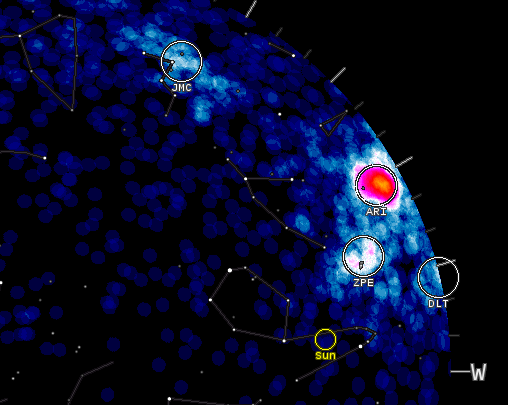
Spaceweather.com is reporting a daytime meteor shower happening this week, causing pings on a meteor radar in Canada, possibly producing some nighttime meteors as well and possibly peaking around the morning of June 7, 2017. This is the Arietid meteor shower, radiating from the direction of our constellation Aries, which is now exceedingly near the sun before dawn and traveling across the sky with the sun during the day. Hence, the daytime meteors. Spaceweather wrote:
This week, Earth is passing through a stream of dusty debris from … where? No one knows for sure. The encounter is causing a daytime meteor shower as meteoroids hit the top of Earth’s atmosphere traveling 39 km/s (87,000 mph). A meteor radar in Canada [CMOR] is tracking strong activity in the constellation Aries not far from the sun. The display is mostly invisible to the human eye – but not entirely. It may be possible to see some of these strange meteors during a narrow window of darkness before sunrise, especially on June 7, when the shower is expected to peak …
If you could turn off the sun, you would see more than 60 meteors per hour, making it one of the most active showers of the year.
What will you see if you look before sunrise? Maybe nothing unusual, but, as always, your chances of seeing meteors will improve in a dark country sky, far from city lights. Spaceweather said:
The shower’s radiant (labeled ARI in the radar map above) rises in the east about 45 minutes before the sun. At that time of day, Arietids tend to be ‘Earthgrazers,’ i.e., meteors that skim horizontally through the upper atmosphere from radiants near the horizon.
Spectacular Earthgrazers are usually slow and bright, streaking far across the sky – a real eye-opener.

MeteorShowersOnline.com has a good writeup on the Arietids, which have been observed via radar since 1947.
Annual meteor showers like this one occur when Earth passes through the icy debris left behind by comet. The origin of the Arietid shower is uncertain, but some astronomers suspect sungrazing asteroid 1566 Icarus, and other point to comet 96P/Machholz.
Bottom line: Information and charts on the (mostly daytime) Arietid meteor shower, which lasts from late May through early June, and which would be one of the year’s strongest showers, if its radiant were not so near the sun. Special thanks to EarthSky reader Carol Rosin for the heads up on the radar image!











